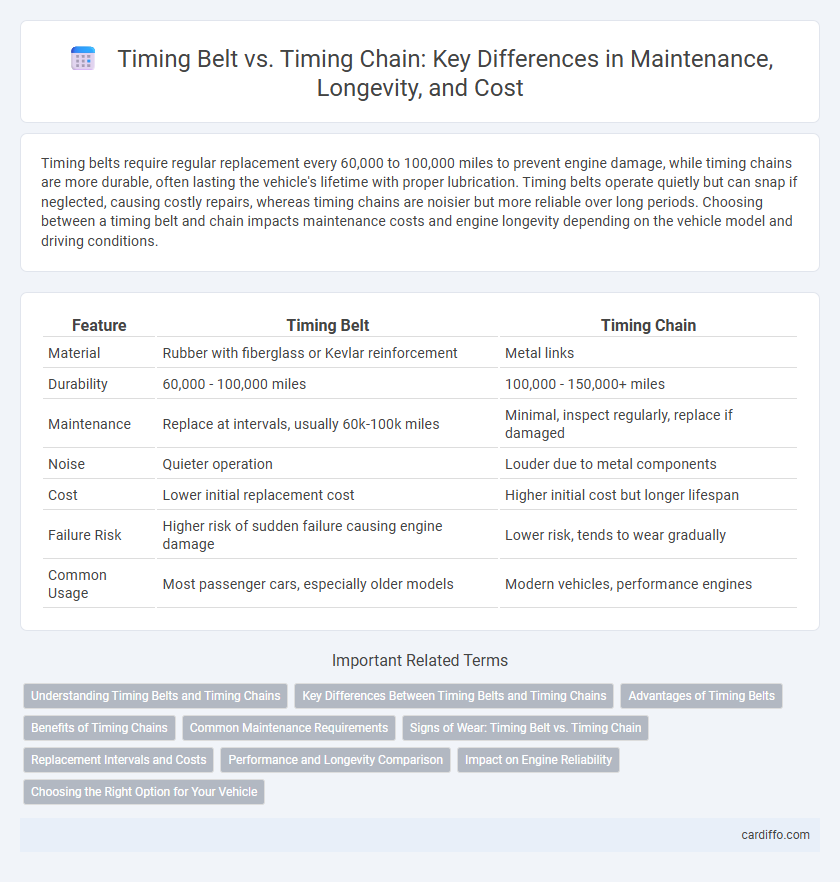Timing belts require regular replacement every 60,000 to 100,000 miles to prevent engine damage, while timing chains are more durable, often lasting the vehicle's lifetime with proper lubrication. Timing belts operate quietly but can snap if neglected, causing costly repairs, whereas timing chains are noisier but more reliable over long periods. Choosing between a timing belt and chain impacts maintenance costs and engine longevity depending on the vehicle model and driving conditions.
Table of Comparison
| Feature | Timing Belt | Timing Chain |
|---|---|---|
| Material | Rubber with fiberglass or Kevlar reinforcement | Metal links |
| Durability | 60,000 - 100,000 miles | 100,000 - 150,000+ miles |
| Maintenance | Replace at intervals, usually 60k-100k miles | Minimal, inspect regularly, replace if damaged |
| Noise | Quieter operation | Louder due to metal components |
| Cost | Lower initial replacement cost | Higher initial cost but longer lifespan |
| Failure Risk | Higher risk of sudden failure causing engine damage | Lower risk, tends to wear gradually |
| Common Usage | Most passenger cars, especially older models | Modern vehicles, performance engines |
Understanding Timing Belts and Timing Chains
Timing belts are made of reinforced rubber and require replacement typically every 60,000 to 100,000 miles to prevent engine damage. Timing chains consist of metal links, are more durable, and usually last the vehicle's lifetime with less frequent maintenance. Understanding the material composition and maintenance intervals of timing belts and chains helps ensure proper engine performance and longevity.
Key Differences Between Timing Belts and Timing Chains
Timing belts are made of reinforced rubber and require replacement every 60,000 to 100,000 miles, whereas timing chains consist of metal links designed to last the vehicle's lifetime with minimal maintenance. Timing chains operate more quietly and are more durable but generally cost more to repair if they fail, while timing belts are cheaper to replace but can cause severe engine damage if they snap. The choice between timing belt and chain affects vehicle maintenance schedules, repair costs, and engine longevity.
Advantages of Timing Belts
Timing belts offer quieter operation and smoother engine performance compared to timing chains, reducing noise and vibrations. They are typically lighter and more cost-effective to manufacture and replace, contributing to lower maintenance expenses. Timing belts also provide precise timing control and are less prone to stretching, enhancing fuel efficiency and engine reliability.
Benefits of Timing Chains
Timing chains offer superior durability and longevity compared to timing belts, often lasting the entire lifespan of the engine without replacement. They provide more precise timing for improved engine performance and are less prone to wear and damage from oil or heat exposure. Maintenance costs are lower over time since timing chains require less frequent service, making them a more reliable choice for modern automotive engines.
Common Maintenance Requirements
Timing belts require periodic replacement, typically every 60,000 to 100,000 miles, to prevent catastrophic engine damage due to wear or failure. Timing chains offer greater durability and often last the vehicle's lifetime but may need intermittent tensioner or guide inspections to avoid slack or noise. Proper maintenance of both components ensures precise engine timing, optimal performance, and prolongs engine life.
Signs of Wear: Timing Belt vs. Timing Chain
Signs of wear on a timing belt include visible cracks, fraying, or missing teeth, often accompanied by engine misfires or unusual noises such as rattling. Timing chain wear typically manifests as a rattling noise from the engine, metal shavings in the oil, or difficulty maintaining proper engine timing, potentially leading to poor performance or engine damage. Regular inspection and timely replacement of these components are crucial to prevent costly engine repairs.
Replacement Intervals and Costs
Timing belts typically require replacement every 60,000 to 100,000 miles, with costs ranging from $300 to $500 due to labor and parts. Timing chains are designed to last longer, often the vehicle's lifetime, but replacement can cost between $1,000 and $3,000 if needed. Regular inspection of either system is essential to avoid engine damage and unexpected maintenance expenses.
Performance and Longevity Comparison
Timing belts offer quieter operation and lighter weight, contributing to improved engine efficiency but generally require replacement every 60,000 to 100,000 miles due to material wear. Timing chains, made of durable metal, provide superior longevity often exceeding 150,000 miles and can withstand higher RPMs without stretching, delivering consistent performance over time. While belts reduce engine noise and vibration, chains excel in durability and maintenance intervals, making them ideal for high-performance and long-term reliability.
Impact on Engine Reliability
Timing belt replacement intervals typically range between 60,000 to 100,000 miles, requiring regular maintenance to prevent engine failure, whereas timing chains are designed for longer durability, often lasting 150,000 miles or more. A worn or broken timing belt can cause severe engine damage, including bent valves or pistons, while timing chain issues usually manifest as noise or stretching, allowing for earlier detection and less catastrophic outcomes. Engine reliability improves significantly with timely timing belt replacement, whereas timing chains provide a more maintenance-free solution but still require inspection for wear to avoid unexpected breakdowns.
Choosing the Right Option for Your Vehicle
Choosing the right timing mechanism for your vehicle depends on factors like engine type, mileage, and manufacturer recommendations. Timing belts offer quieter operation and better fuel efficiency but require regular replacement around 60,000 to 100,000 miles to prevent engine damage. Timing chains provide greater durability and longevity, often lasting over 200,000 miles, making them ideal for high-performance or heavy-duty vehicles with less frequent maintenance intervals.
Timing Belt vs Timing Chain Infographic

 cardiffo.com
cardiffo.com